Applied Sustainable Construction Technology and Measurement Report
VerifiedAdded on 2023/05/29
|23
|5155
|166
Report
AI Summary
This report provides an in-depth analysis of sustainable construction technologies, focusing on a case study of a warehouse in London. The report explores various aspects of the building's construction, including the portal frame design, roofing system, cladding system, and ceiling system. The roofing system is examined in detail, with an analysis of the materials used, temperature monitoring, and the importance of material replacement for improved performance. The cladding system, which protects the building's external surface, is also discussed, including the materials used and their application. The ceiling system is analyzed in the context of the building's design, highlighting the use of transparent ceilings and metal-plated steel components. Furthermore, the report examines the heating, cooling, ventilation, and air quality control systems, along with the use of doors, windows, and mechanical appliances. The report emphasizes sustainable practices and the importance of material selection and design choices in achieving energy efficiency and environmental performance in building construction.
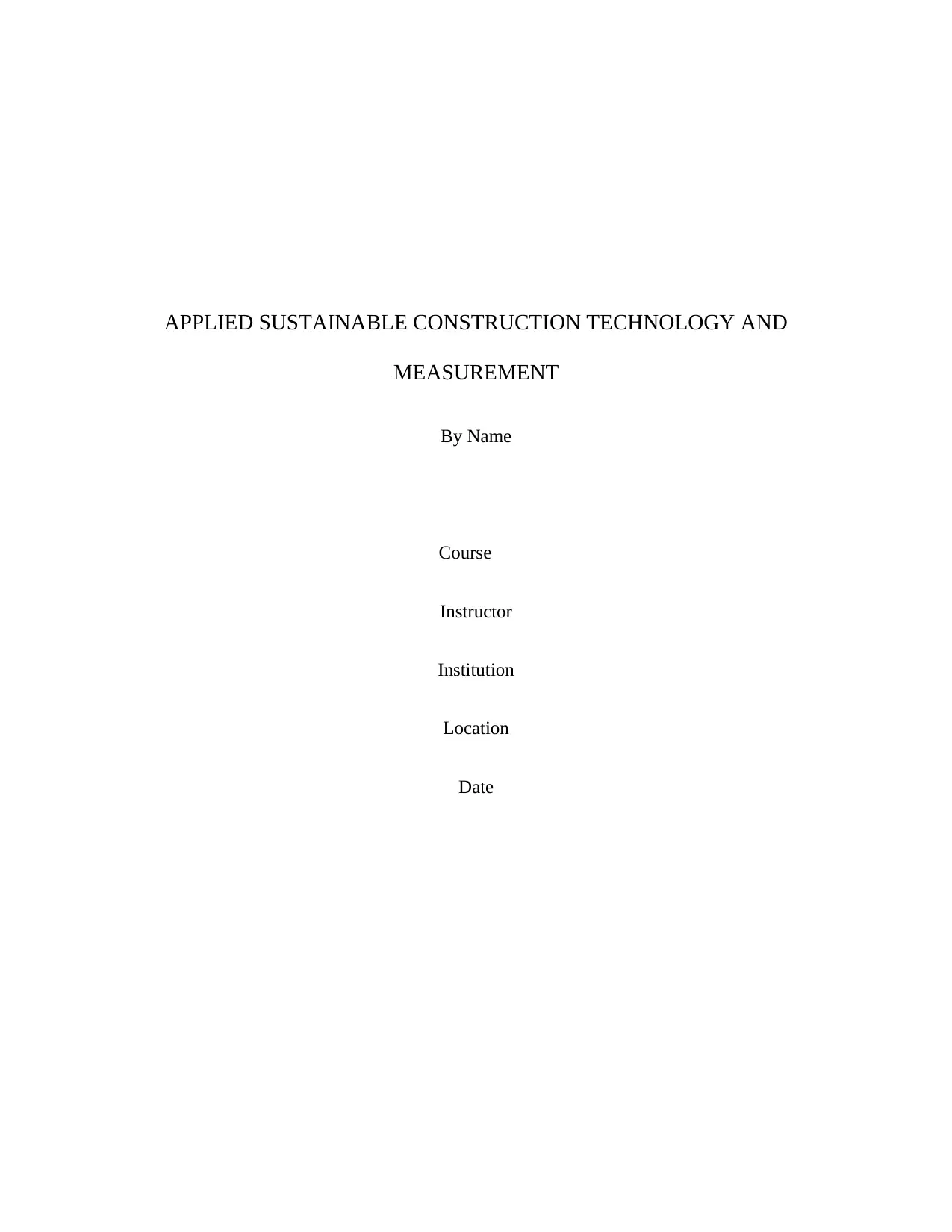
APPLIED SUSTAINABLE CONSTRUCTION TECHNOLOGY AND
MEASUREMENT
By Name
Course
Instructor
Institution
Location
Date
MEASUREMENT
By Name
Course
Instructor
Institution
Location
Date
Paraphrase This Document
Need a fresh take? Get an instant paraphrase of this document with our AI Paraphraser

INTRODUCTION
The portal refers to the method of constructing and designing structures in which the two-
dimensional rigid frames with the basic properties of the rigid joint are placed between the beam
and the column for proper utilization. The major reason for using this particular technique for the
design and the construction is to ensure that there is a proper deduction in the bending moments
in the beam. This application allows the frame to be used as one structural unit. When this kind
of the application is put in place, the size of the structural element can be possibly lowered while
allowing for the increase of the span for the same size of the structural elements. As a result of
this kind of the technique, the portal frame is regarded as the most reliable and efficient method
of the construction for those buildings with the long span(Nowak and Collins 2012).
The portal frame is normally used in the low rise structures that are made up of the beam, pitched
rafters and columns that are connected by the moment resisting connections. The resistance to
the lateral and the vertical actions is normally provided by the suitable haunch or the deepening
of the sections of the rafters. This kind of the structure of the continuous frame is normally stable
in its plane and it provides a clear span that is never obstructed by the bracing. In most of the
cases, the application of the construction of the portal frame is at the single level structures band
it is normally seen in the construction of the factories, bans, warehouse and other places where
large open spaces are required at cheaper prices and there is acceptance of the pitched roof
A portal frame is normally made up of the transverse frames that are in series and are braced
longitudinally. The primary steelwork is made up of the columns and the rafters that make the
form bracing and the portal frame. The light gauge secondary steelwork comprises the side rails
The portal refers to the method of constructing and designing structures in which the two-
dimensional rigid frames with the basic properties of the rigid joint are placed between the beam
and the column for proper utilization. The major reason for using this particular technique for the
design and the construction is to ensure that there is a proper deduction in the bending moments
in the beam. This application allows the frame to be used as one structural unit. When this kind
of the application is put in place, the size of the structural element can be possibly lowered while
allowing for the increase of the span for the same size of the structural elements. As a result of
this kind of the technique, the portal frame is regarded as the most reliable and efficient method
of the construction for those buildings with the long span(Nowak and Collins 2012).
The portal frame is normally used in the low rise structures that are made up of the beam, pitched
rafters and columns that are connected by the moment resisting connections. The resistance to
the lateral and the vertical actions is normally provided by the suitable haunch or the deepening
of the sections of the rafters. This kind of the structure of the continuous frame is normally stable
in its plane and it provides a clear span that is never obstructed by the bracing. In most of the
cases, the application of the construction of the portal frame is at the single level structures band
it is normally seen in the construction of the factories, bans, warehouse and other places where
large open spaces are required at cheaper prices and there is acceptance of the pitched roof
A portal frame is normally made up of the transverse frames that are in series and are braced
longitudinally. The primary steelwork is made up of the columns and the rafters that make the
form bracing and the portal frame. The light gauge secondary steelwork comprises the side rails
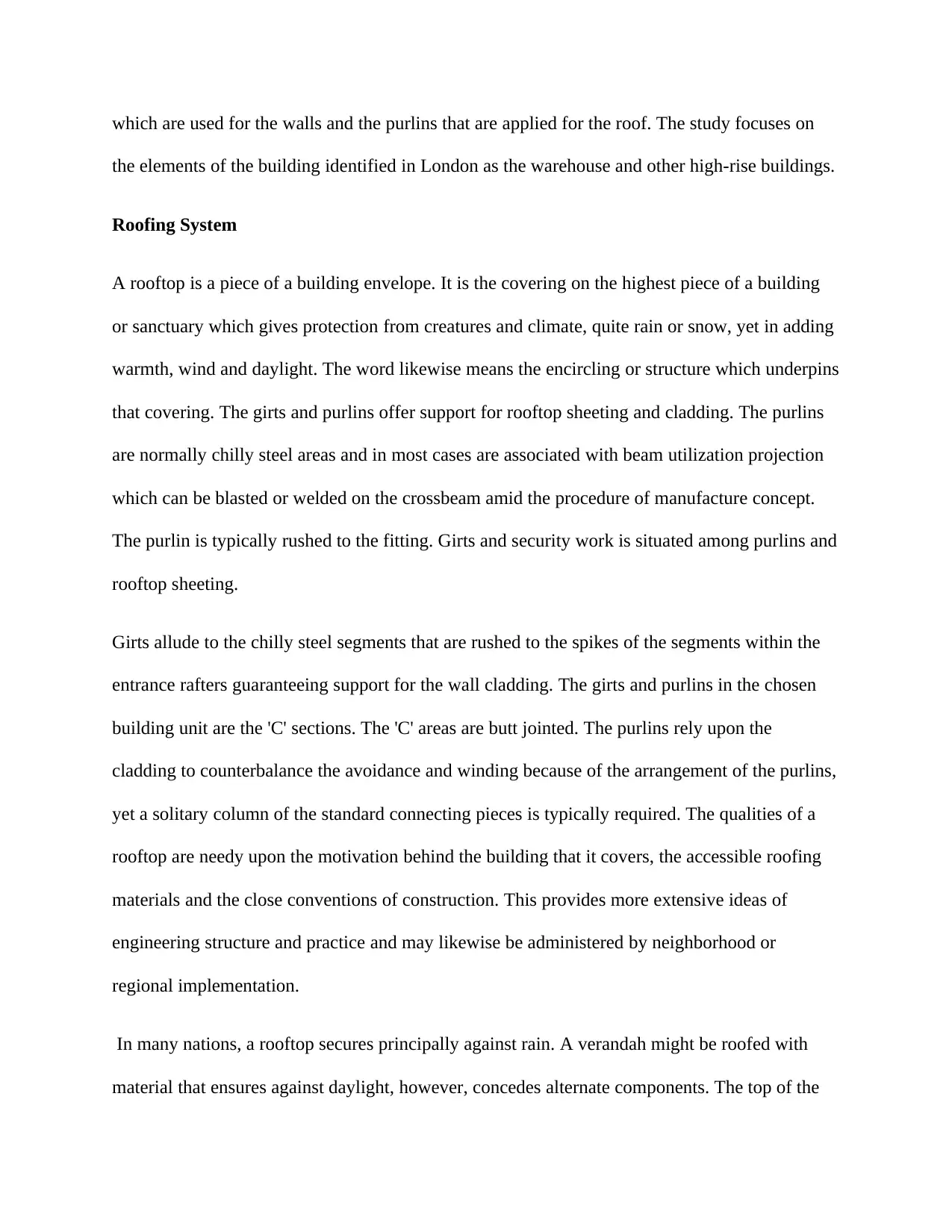
which are used for the walls and the purlins that are applied for the roof. The study focuses on
the elements of the building identified in London as the warehouse and other high-rise buildings.
Roofing System
A rooftop is a piece of a building envelope. It is the covering on the highest piece of a building
or sanctuary which gives protection from creatures and climate, quite rain or snow, yet in adding
warmth, wind and daylight. The word likewise means the encircling or structure which underpins
that covering. The girts and purlins offer support for rooftop sheeting and cladding. The purlins
are normally chilly steel areas and in most cases are associated with beam utilization projection
which can be blasted or welded on the crossbeam amid the procedure of manufacture concept.
The purlin is typically rushed to the fitting. Girts and security work is situated among purlins and
rooftop sheeting.
Girts allude to the chilly steel segments that are rushed to the spikes of the segments within the
entrance rafters guaranteeing support for the wall cladding. The girts and purlins in the chosen
building unit are the 'C' sections. The 'C' areas are butt jointed. The purlins rely upon the
cladding to counterbalance the avoidance and winding because of the arrangement of the purlins,
yet a solitary column of the standard connecting pieces is typically required. The qualities of a
rooftop are needy upon the motivation behind the building that it covers, the accessible roofing
materials and the close conventions of construction. This provides more extensive ideas of
engineering structure and practice and may likewise be administered by neighborhood or
regional implementation.
In many nations, a rooftop secures principally against rain. A verandah might be roofed with
material that ensures against daylight, however, concedes alternate components. The top of the
the elements of the building identified in London as the warehouse and other high-rise buildings.
Roofing System
A rooftop is a piece of a building envelope. It is the covering on the highest piece of a building
or sanctuary which gives protection from creatures and climate, quite rain or snow, yet in adding
warmth, wind and daylight. The word likewise means the encircling or structure which underpins
that covering. The girts and purlins offer support for rooftop sheeting and cladding. The purlins
are normally chilly steel areas and in most cases are associated with beam utilization projection
which can be blasted or welded on the crossbeam amid the procedure of manufacture concept.
The purlin is typically rushed to the fitting. Girts and security work is situated among purlins and
rooftop sheeting.
Girts allude to the chilly steel segments that are rushed to the spikes of the segments within the
entrance rafters guaranteeing support for the wall cladding. The girts and purlins in the chosen
building unit are the 'C' sections. The 'C' areas are butt jointed. The purlins rely upon the
cladding to counterbalance the avoidance and winding because of the arrangement of the purlins,
yet a solitary column of the standard connecting pieces is typically required. The qualities of a
rooftop are needy upon the motivation behind the building that it covers, the accessible roofing
materials and the close conventions of construction. This provides more extensive ideas of
engineering structure and practice and may likewise be administered by neighborhood or
regional implementation.
In many nations, a rooftop secures principally against rain. A verandah might be roofed with
material that ensures against daylight, however, concedes alternate components. The top of the
⊘ This is a preview!⊘
Do you want full access?
Subscribe today to unlock all pages.

Trusted by 1+ million students worldwide
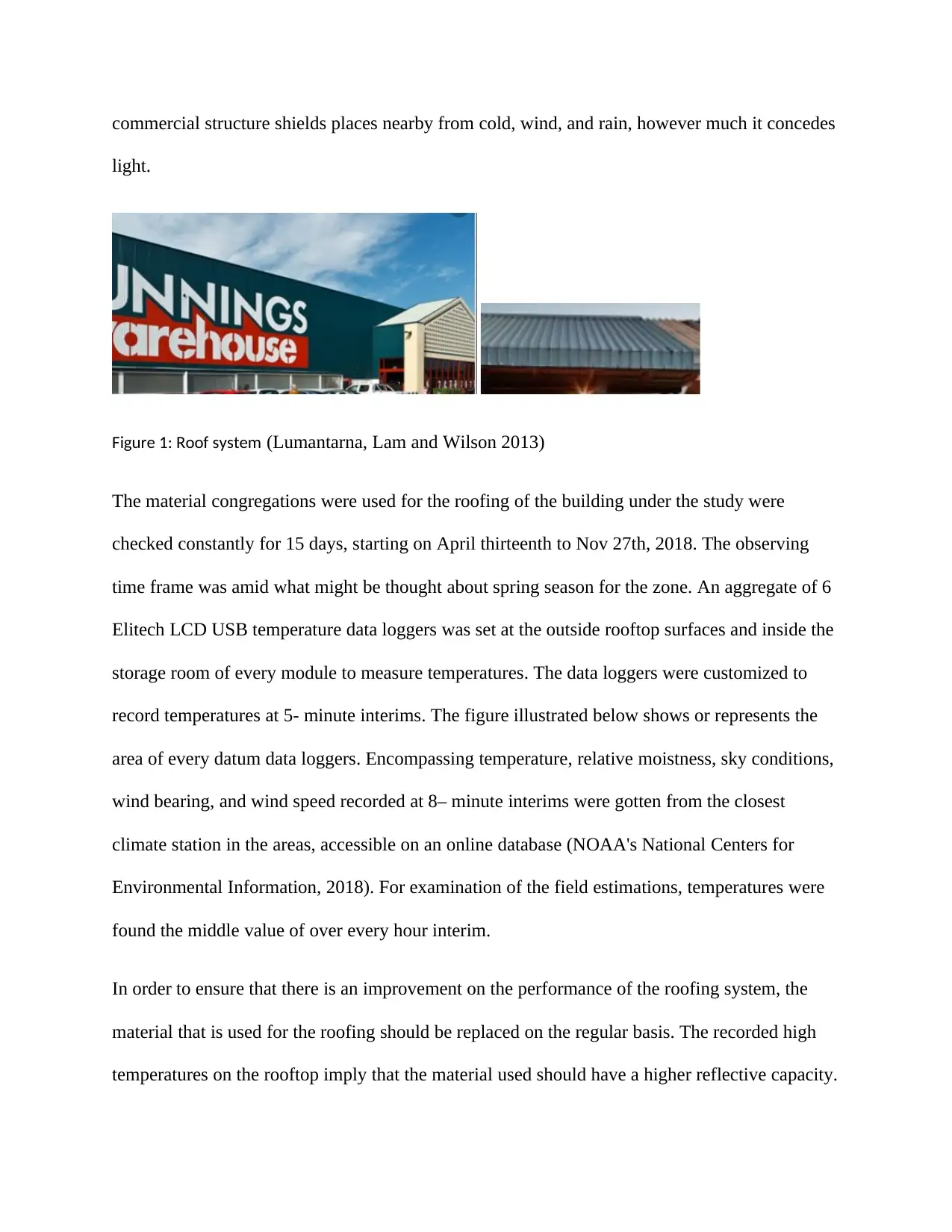
commercial structure shields places nearby from cold, wind, and rain, however much it concedes
light.
Figure 1: Roof system (Lumantarna, Lam and Wilson 2013)
The material congregations were used for the roofing of the building under the study were
checked constantly for 15 days, starting on April thirteenth to Nov 27th, 2018. The observing
time frame was amid what might be thought about spring season for the zone. An aggregate of 6
Elitech LCD USB temperature data loggers was set at the outside rooftop surfaces and inside the
storage room of every module to measure temperatures. The data loggers were customized to
record temperatures at 5- minute interims. The figure illustrated below shows or represents the
area of every datum data loggers. Encompassing temperature, relative moistness, sky conditions,
wind bearing, and wind speed recorded at 8– minute interims were gotten from the closest
climate station in the areas, accessible on an online database (NOAA's National Centers for
Environmental Information, 2018). For examination of the field estimations, temperatures were
found the middle value of over every hour interim.
In order to ensure that there is an improvement on the performance of the roofing system, the
material that is used for the roofing should be replaced on the regular basis. The recorded high
temperatures on the rooftop imply that the material used should have a higher reflective capacity.
light.
Figure 1: Roof system (Lumantarna, Lam and Wilson 2013)
The material congregations were used for the roofing of the building under the study were
checked constantly for 15 days, starting on April thirteenth to Nov 27th, 2018. The observing
time frame was amid what might be thought about spring season for the zone. An aggregate of 6
Elitech LCD USB temperature data loggers was set at the outside rooftop surfaces and inside the
storage room of every module to measure temperatures. The data loggers were customized to
record temperatures at 5- minute interims. The figure illustrated below shows or represents the
area of every datum data loggers. Encompassing temperature, relative moistness, sky conditions,
wind bearing, and wind speed recorded at 8– minute interims were gotten from the closest
climate station in the areas, accessible on an online database (NOAA's National Centers for
Environmental Information, 2018). For examination of the field estimations, temperatures were
found the middle value of over every hour interim.
In order to ensure that there is an improvement on the performance of the roofing system, the
material that is used for the roofing should be replaced on the regular basis. The recorded high
temperatures on the rooftop imply that the material used should have a higher reflective capacity.
Paraphrase This Document
Need a fresh take? Get an instant paraphrase of this document with our AI Paraphraser
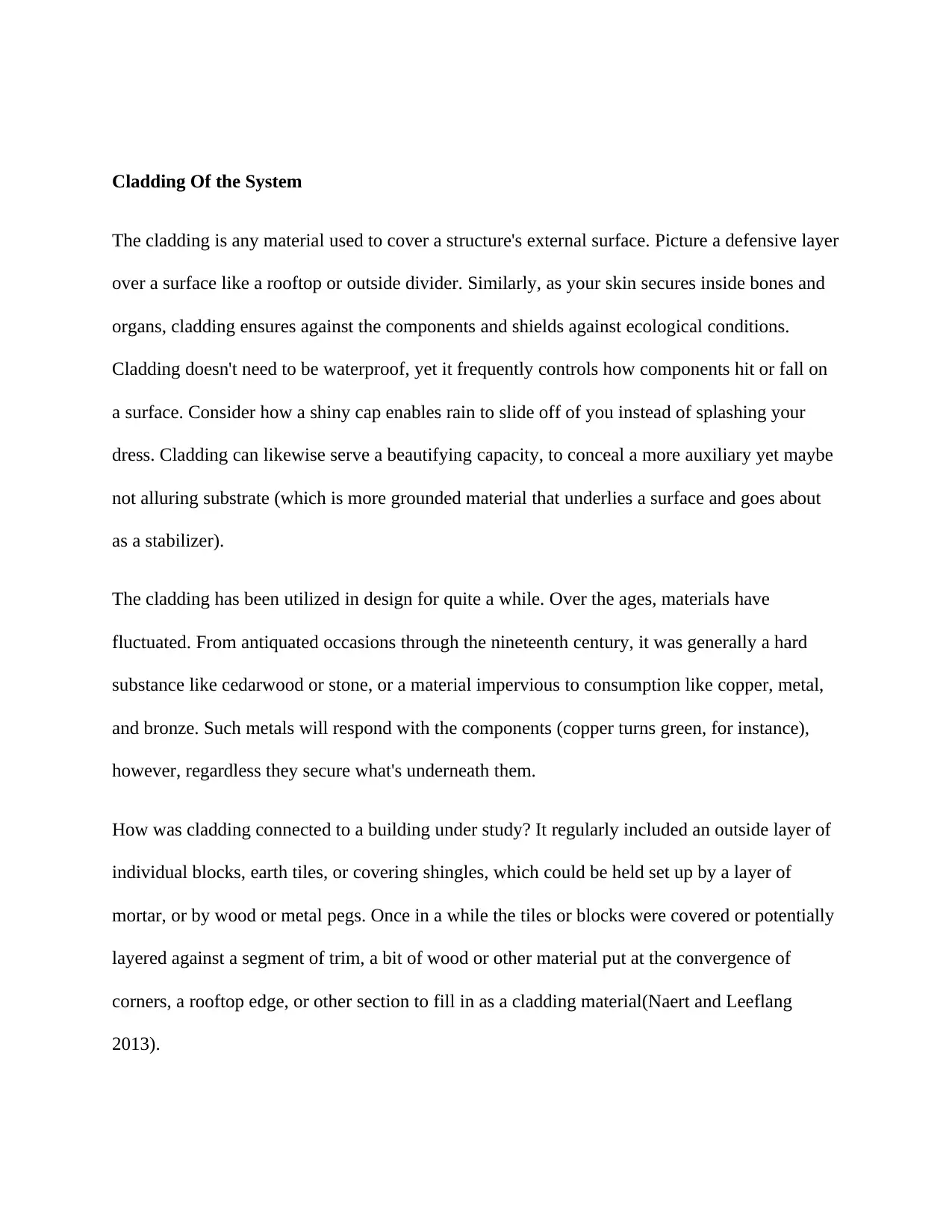
Cladding Of the System
The cladding is any material used to cover a structure's external surface. Picture a defensive layer
over a surface like a rooftop or outside divider. Similarly, as your skin secures inside bones and
organs, cladding ensures against the components and shields against ecological conditions.
Cladding doesn't need to be waterproof, yet it frequently controls how components hit or fall on
a surface. Consider how a shiny cap enables rain to slide off of you instead of splashing your
dress. Cladding can likewise serve a beautifying capacity, to conceal a more auxiliary yet maybe
not alluring substrate (which is more grounded material that underlies a surface and goes about
as a stabilizer).
The cladding has been utilized in design for quite a while. Over the ages, materials have
fluctuated. From antiquated occasions through the nineteenth century, it was generally a hard
substance like cedarwood or stone, or a material impervious to consumption like copper, metal,
and bronze. Such metals will respond with the components (copper turns green, for instance),
however, regardless they secure what's underneath them.
How was cladding connected to a building under study? It regularly included an outside layer of
individual blocks, earth tiles, or covering shingles, which could be held set up by a layer of
mortar, or by wood or metal pegs. Once in a while the tiles or blocks were covered or potentially
layered against a segment of trim, a bit of wood or other material put at the convergence of
corners, a rooftop edge, or other section to fill in as a cladding material(Naert and Leeflang
2013).
The cladding is any material used to cover a structure's external surface. Picture a defensive layer
over a surface like a rooftop or outside divider. Similarly, as your skin secures inside bones and
organs, cladding ensures against the components and shields against ecological conditions.
Cladding doesn't need to be waterproof, yet it frequently controls how components hit or fall on
a surface. Consider how a shiny cap enables rain to slide off of you instead of splashing your
dress. Cladding can likewise serve a beautifying capacity, to conceal a more auxiliary yet maybe
not alluring substrate (which is more grounded material that underlies a surface and goes about
as a stabilizer).
The cladding has been utilized in design for quite a while. Over the ages, materials have
fluctuated. From antiquated occasions through the nineteenth century, it was generally a hard
substance like cedarwood or stone, or a material impervious to consumption like copper, metal,
and bronze. Such metals will respond with the components (copper turns green, for instance),
however, regardless they secure what's underneath them.
How was cladding connected to a building under study? It regularly included an outside layer of
individual blocks, earth tiles, or covering shingles, which could be held set up by a layer of
mortar, or by wood or metal pegs. Once in a while the tiles or blocks were covered or potentially
layered against a segment of trim, a bit of wood or other material put at the convergence of
corners, a rooftop edge, or other section to fill in as a cladding material(Naert and Leeflang
2013).
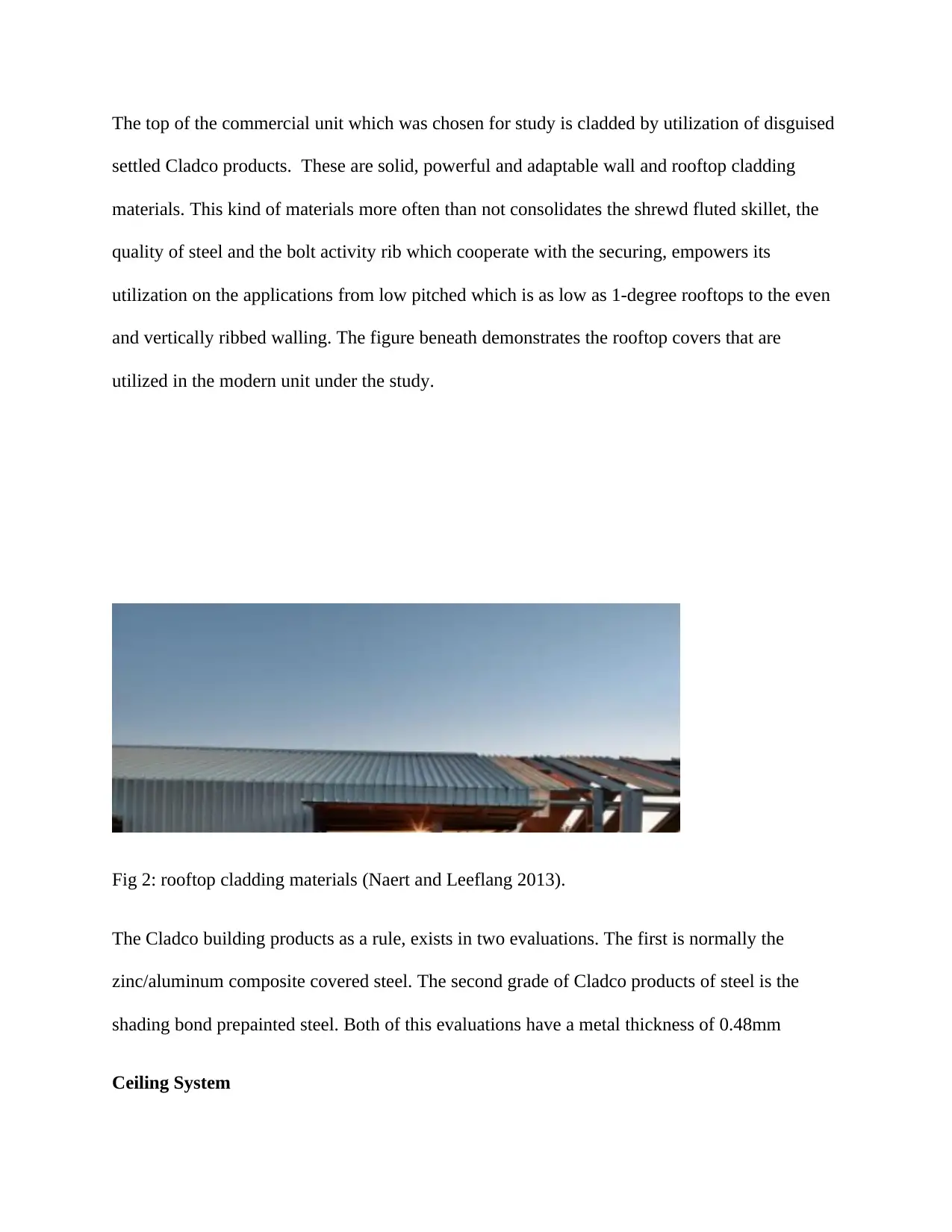
The top of the commercial unit which was chosen for study is cladded by utilization of disguised
settled Cladco products. These are solid, powerful and adaptable wall and rooftop cladding
materials. This kind of materials more often than not consolidates the shrewd fluted skillet, the
quality of steel and the bolt activity rib which cooperate with the securing, empowers its
utilization on the applications from low pitched which is as low as 1-degree rooftops to the even
and vertically ribbed walling. The figure beneath demonstrates the rooftop covers that are
utilized in the modern unit under the study.
Fig 2: rooftop cladding materials (Naert and Leeflang 2013).
The Cladco building products as a rule, exists in two evaluations. The first is normally the
zinc/aluminum composite covered steel. The second grade of Cladco products of steel is the
shading bond prepainted steel. Both of this evaluations have a metal thickness of 0.48mm
Ceiling System
settled Cladco products. These are solid, powerful and adaptable wall and rooftop cladding
materials. This kind of materials more often than not consolidates the shrewd fluted skillet, the
quality of steel and the bolt activity rib which cooperate with the securing, empowers its
utilization on the applications from low pitched which is as low as 1-degree rooftops to the even
and vertically ribbed walling. The figure beneath demonstrates the rooftop covers that are
utilized in the modern unit under the study.
Fig 2: rooftop cladding materials (Naert and Leeflang 2013).
The Cladco building products as a rule, exists in two evaluations. The first is normally the
zinc/aluminum composite covered steel. The second grade of Cladco products of steel is the
shading bond prepainted steel. Both of this evaluations have a metal thickness of 0.48mm
Ceiling System
⊘ This is a preview!⊘
Do you want full access?
Subscribe today to unlock all pages.

Trusted by 1+ million students worldwide

A ceiling refers to the overhead interior that covers the upper limit of the building or room. The
components of the ceiling are never considered as the structural element. It is normally regarded
as a finished surface that conceals the underside of the roof structure. The ceiling can be possibly
decorated to provide taste. The building under study exhibited two particular plan difficulties: the
first started from the customer's prerequisites – how to expound a building relationship and
develop limits between the different capacities. The second turned into a more profound
addressing of how to approach structure with regards to a legacy building. The multifaceted
nature of the project required a high level of ceiling between the different regions. Some portion
of the flood zone was to be assigned for lasting Crew Collective workers and was to contain
meeting rooms and in addition other commercial uses(Lee,Jung, Park, Lee and Yoon 2013).
Different zones were to be leased to independent laborers either constantly or continuously, with
these specialists additionally requiring access to meeting rooms. In summary, brief specialists or
people, in general, could likewise utilize the bistro and the work areas for a couple of hours, have
Wi-Fi access, and lockers for their very own PCs as required. These conditions were intended to
make a stream and empower associations between constant and experienced specialists. The
perfect ceiling was therefore considered one of the attractive features of the building(Thompson,
Macfarlan and Lorincz 2016).
The plan was intended to encourage this stream by making straightforward and translucent
ceiling between the different office spaces and commercial rooms. An intricate arrangement of
glass walls was raised between the different zones, with a characterized access to mirror level of
permanency for every user group. Unique bank employee stands, going once again from the old
design, must be held. As a result, they turned into a characteristic outskirt between the bistro
space and the meeting rooms that, thus, made a partition between the more open spaces and the
components of the ceiling are never considered as the structural element. It is normally regarded
as a finished surface that conceals the underside of the roof structure. The ceiling can be possibly
decorated to provide taste. The building under study exhibited two particular plan difficulties: the
first started from the customer's prerequisites – how to expound a building relationship and
develop limits between the different capacities. The second turned into a more profound
addressing of how to approach structure with regards to a legacy building. The multifaceted
nature of the project required a high level of ceiling between the different regions. Some portion
of the flood zone was to be assigned for lasting Crew Collective workers and was to contain
meeting rooms and in addition other commercial uses(Lee,Jung, Park, Lee and Yoon 2013).
Different zones were to be leased to independent laborers either constantly or continuously, with
these specialists additionally requiring access to meeting rooms. In summary, brief specialists or
people, in general, could likewise utilize the bistro and the work areas for a couple of hours, have
Wi-Fi access, and lockers for their very own PCs as required. These conditions were intended to
make a stream and empower associations between constant and experienced specialists. The
perfect ceiling was therefore considered one of the attractive features of the building(Thompson,
Macfarlan and Lorincz 2016).
The plan was intended to encourage this stream by making straightforward and translucent
ceiling between the different office spaces and commercial rooms. An intricate arrangement of
glass walls was raised between the different zones, with a characterized access to mirror level of
permanency for every user group. Unique bank employee stands, going once again from the old
design, must be held. As a result, they turned into a characteristic outskirt between the bistro
space and the meeting rooms that, thus, made a partition between the more open spaces and the
Paraphrase This Document
Need a fresh take? Get an instant paraphrase of this document with our AI Paraphraser
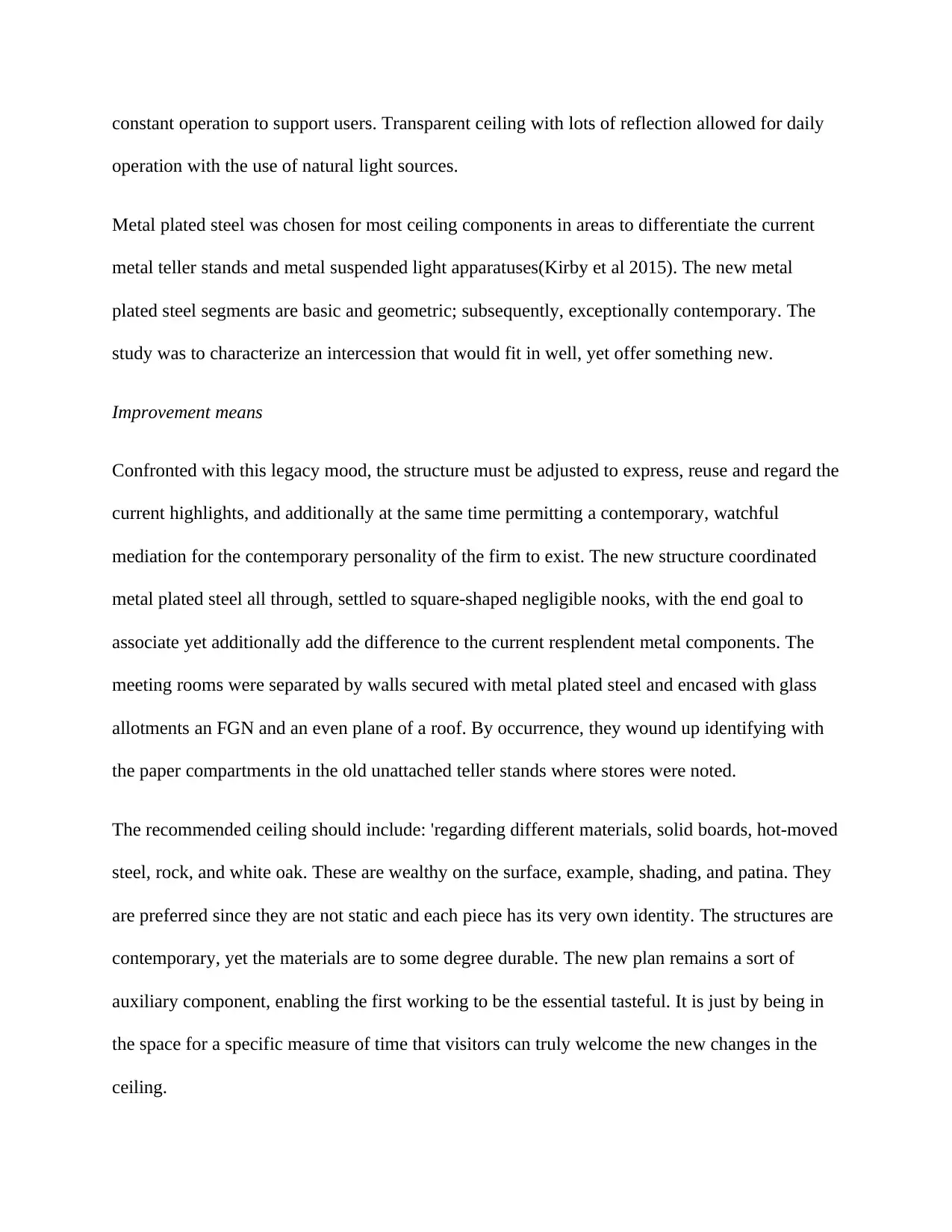
constant operation to support users. Transparent ceiling with lots of reflection allowed for daily
operation with the use of natural light sources.
Metal plated steel was chosen for most ceiling components in areas to differentiate the current
metal teller stands and metal suspended light apparatuses(Kirby et al 2015). The new metal
plated steel segments are basic and geometric; subsequently, exceptionally contemporary. The
study was to characterize an intercession that would fit in well, yet offer something new.
Improvement means
Confronted with this legacy mood, the structure must be adjusted to express, reuse and regard the
current highlights, and additionally at the same time permitting a contemporary, watchful
mediation for the contemporary personality of the firm to exist. The new structure coordinated
metal plated steel all through, settled to square-shaped negligible nooks, with the end goal to
associate yet additionally add the difference to the current resplendent metal components. The
meeting rooms were separated by walls secured with metal plated steel and encased with glass
allotments an FGN and an even plane of a roof. By occurrence, they wound up identifying with
the paper compartments in the old unattached teller stands where stores were noted.
The recommended ceiling should include: 'regarding different materials, solid boards, hot-moved
steel, rock, and white oak. These are wealthy on the surface, example, shading, and patina. They
are preferred since they are not static and each piece has its very own identity. The structures are
contemporary, yet the materials are to some degree durable. The new plan remains a sort of
auxiliary component, enabling the first working to be the essential tasteful. It is just by being in
the space for a specific measure of time that visitors can truly welcome the new changes in the
ceiling.
operation with the use of natural light sources.
Metal plated steel was chosen for most ceiling components in areas to differentiate the current
metal teller stands and metal suspended light apparatuses(Kirby et al 2015). The new metal
plated steel segments are basic and geometric; subsequently, exceptionally contemporary. The
study was to characterize an intercession that would fit in well, yet offer something new.
Improvement means
Confronted with this legacy mood, the structure must be adjusted to express, reuse and regard the
current highlights, and additionally at the same time permitting a contemporary, watchful
mediation for the contemporary personality of the firm to exist. The new structure coordinated
metal plated steel all through, settled to square-shaped negligible nooks, with the end goal to
associate yet additionally add the difference to the current resplendent metal components. The
meeting rooms were separated by walls secured with metal plated steel and encased with glass
allotments an FGN and an even plane of a roof. By occurrence, they wound up identifying with
the paper compartments in the old unattached teller stands where stores were noted.
The recommended ceiling should include: 'regarding different materials, solid boards, hot-moved
steel, rock, and white oak. These are wealthy on the surface, example, shading, and patina. They
are preferred since they are not static and each piece has its very own identity. The structures are
contemporary, yet the materials are to some degree durable. The new plan remains a sort of
auxiliary component, enabling the first working to be the essential tasteful. It is just by being in
the space for a specific measure of time that visitors can truly welcome the new changes in the
ceiling.
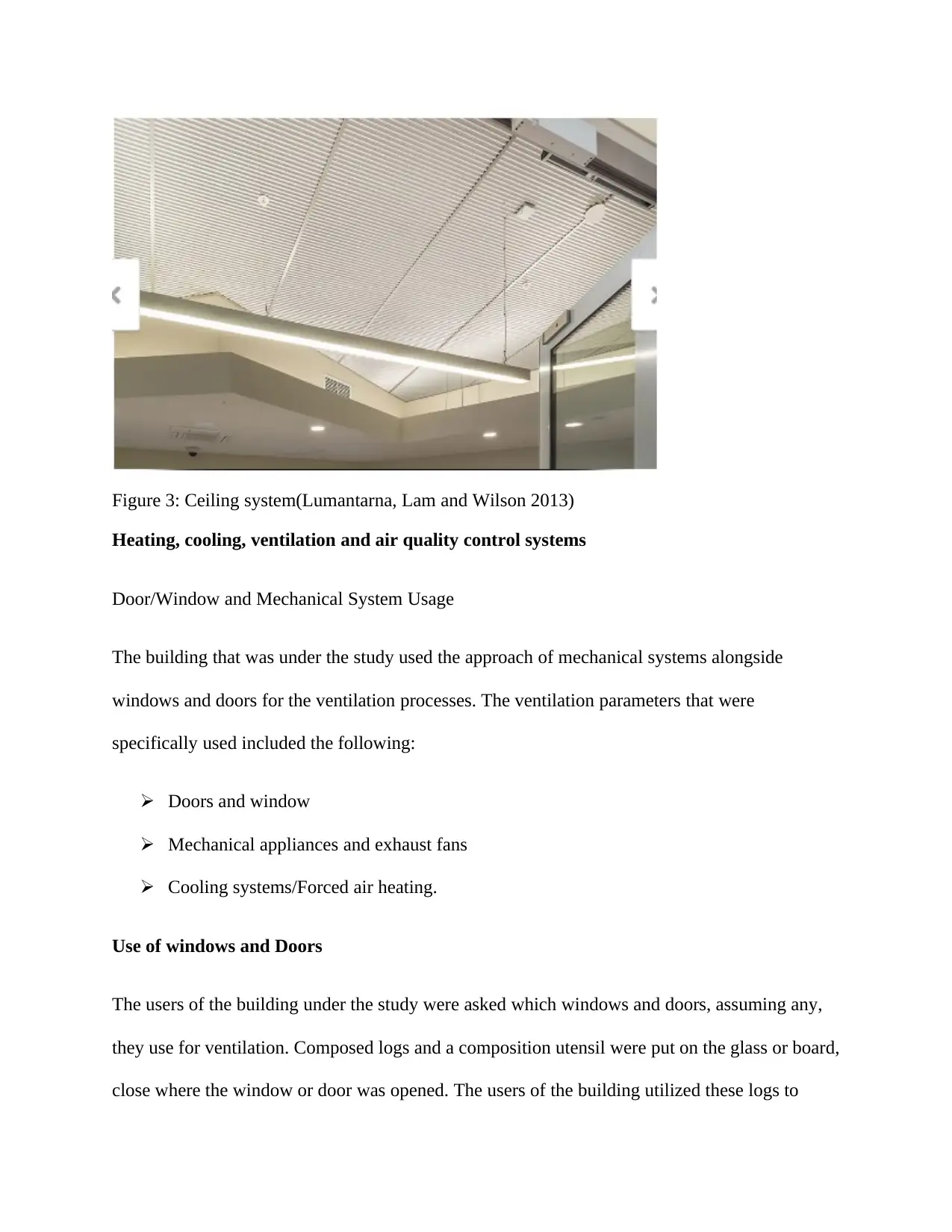
Figure 3: Ceiling system(Lumantarna, Lam and Wilson 2013)
Heating, cooling, ventilation and air quality control systems
Door/Window and Mechanical System Usage
The building that was under the study used the approach of mechanical systems alongside
windows and doors for the ventilation processes. The ventilation parameters that were
specifically used included the following:
Doors and window
Mechanical appliances and exhaust fans
Cooling systems/Forced air heating.
Use of windows and Doors
The users of the building under the study were asked which windows and doors, assuming any,
they use for ventilation. Composed logs and a composition utensil were put on the glass or board,
close where the window or door was opened. The users of the building utilized these logs to
Heating, cooling, ventilation and air quality control systems
Door/Window and Mechanical System Usage
The building that was under the study used the approach of mechanical systems alongside
windows and doors for the ventilation processes. The ventilation parameters that were
specifically used included the following:
Doors and window
Mechanical appliances and exhaust fans
Cooling systems/Forced air heating.
Use of windows and Doors
The users of the building under the study were asked which windows and doors, assuming any,
they use for ventilation. Composed logs and a composition utensil were put on the glass or board,
close where the window or door was opened. The users of the building utilized these logs to
⊘ This is a preview!⊘
Do you want full access?
Subscribe today to unlock all pages.

Trusted by 1+ million students worldwide
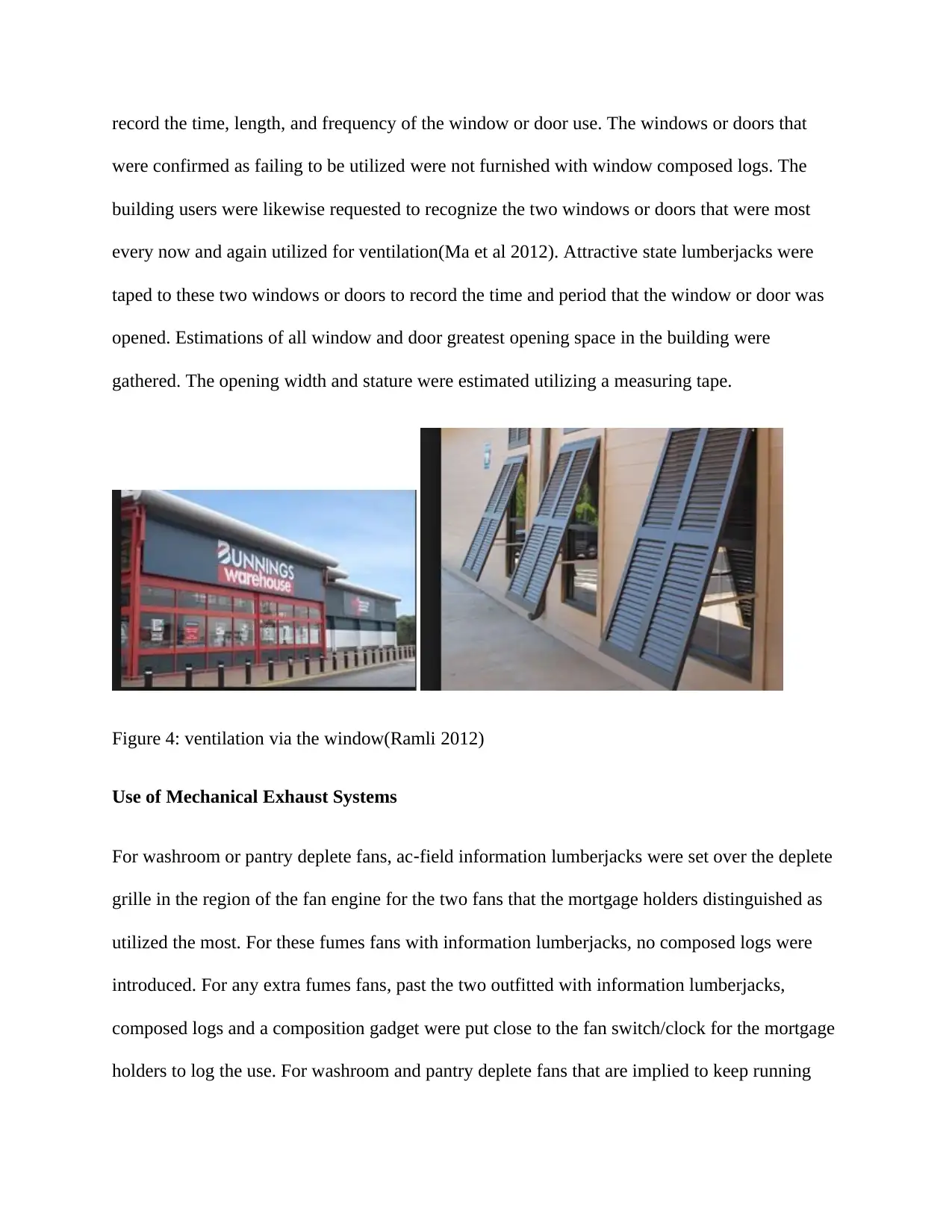
record the time, length, and frequency of the window or door use. The windows or doors that
were confirmed as failing to be utilized were not furnished with window composed logs. The
building users were likewise requested to recognize the two windows or doors that were most
every now and again utilized for ventilation(Ma et al 2012). Attractive state lumberjacks were
taped to these two windows or doors to record the time and period that the window or door was
opened. Estimations of all window and door greatest opening space in the building were
gathered. The opening width and stature were estimated utilizing a measuring tape.
Figure 4: ventilation via the window(Ramli 2012)
Use of Mechanical Exhaust Systems
For washroom or pantry deplete fans, ac‐field information lumberjacks were set over the deplete
grille in the region of the fan engine for the two fans that the mortgage holders distinguished as
utilized the most. For these fumes fans with information lumberjacks, no composed logs were
introduced. For any extra fumes fans, past the two outfitted with information lumberjacks,
composed logs and a composition gadget were put close to the fan switch/clock for the mortgage
holders to log the use. For washroom and pantry deplete fans that are implied to keep running
were confirmed as failing to be utilized were not furnished with window composed logs. The
building users were likewise requested to recognize the two windows or doors that were most
every now and again utilized for ventilation(Ma et al 2012). Attractive state lumberjacks were
taped to these two windows or doors to record the time and period that the window or door was
opened. Estimations of all window and door greatest opening space in the building were
gathered. The opening width and stature were estimated utilizing a measuring tape.
Figure 4: ventilation via the window(Ramli 2012)
Use of Mechanical Exhaust Systems
For washroom or pantry deplete fans, ac‐field information lumberjacks were set over the deplete
grille in the region of the fan engine for the two fans that the mortgage holders distinguished as
utilized the most. For these fumes fans with information lumberjacks, no composed logs were
introduced. For any extra fumes fans, past the two outfitted with information lumberjacks,
composed logs and a composition gadget were put close to the fan switch/clock for the mortgage
holders to log the use. For washroom and pantry deplete fans that are implied to keep running
Paraphrase This Document
Need a fresh take? Get an instant paraphrase of this document with our AI Paraphraser

consistently, for example, HRVs, the property holder was addressed about the use and for those
HRVs that were accounted for to work discontinuously, either a composed log or an ac‐field
information lumberjack was introduced.
For garments dryer debilitate machines, an ac‐field information lumberjack was snared
straightforwardly onto the control line of the dryer utilizing a zip‐tie, and electrical tape if
necessary, or an ac‐field sensor was clasped to the power rope and connected specifically to the
information lumberjack. For kitchen go hood deplete fans, composed logs, and composition
gadgets were set on the walls or microwave close to the fan switch for the property users to log
the use and fan speed(Galetakis, Alevizos and Leventakis 2012).
All washroom and pantry debilitate fan wind current rates were resolved to utilize a balometers
flow hood. Where the fumes channel was available along the outside mass of the building,
kitchen run hood debilitate fan wind stream rates were resolved to utilize a balometers flow
hood. For those homes where the fumes conduit was not available, the normal airspeed was
estimated at the hood air channels and the channel measurements were gathered utilizing a
measuring tape. Where the fumes conduit was open along the outside mass of the building the
dryer debilitate wind stream rate was resolved to utilize a barometer flow hood. The identified
exhaust system of the building as per the study was as shown below.
HRVs that were accounted for to work discontinuously, either a composed log or an ac‐field
information lumberjack was introduced.
For garments dryer debilitate machines, an ac‐field information lumberjack was snared
straightforwardly onto the control line of the dryer utilizing a zip‐tie, and electrical tape if
necessary, or an ac‐field sensor was clasped to the power rope and connected specifically to the
information lumberjack. For kitchen go hood deplete fans, composed logs, and composition
gadgets were set on the walls or microwave close to the fan switch for the property users to log
the use and fan speed(Galetakis, Alevizos and Leventakis 2012).
All washroom and pantry debilitate fan wind current rates were resolved to utilize a balometers
flow hood. Where the fumes channel was available along the outside mass of the building,
kitchen run hood debilitate fan wind stream rates were resolved to utilize a balometers flow
hood. For those homes where the fumes conduit was not available, the normal airspeed was
estimated at the hood air channels and the channel measurements were gathered utilizing a
measuring tape. Where the fumes conduit was open along the outside mass of the building the
dryer debilitate wind stream rate was resolved to utilize a barometer flow hood. The identified
exhaust system of the building as per the study was as shown below.
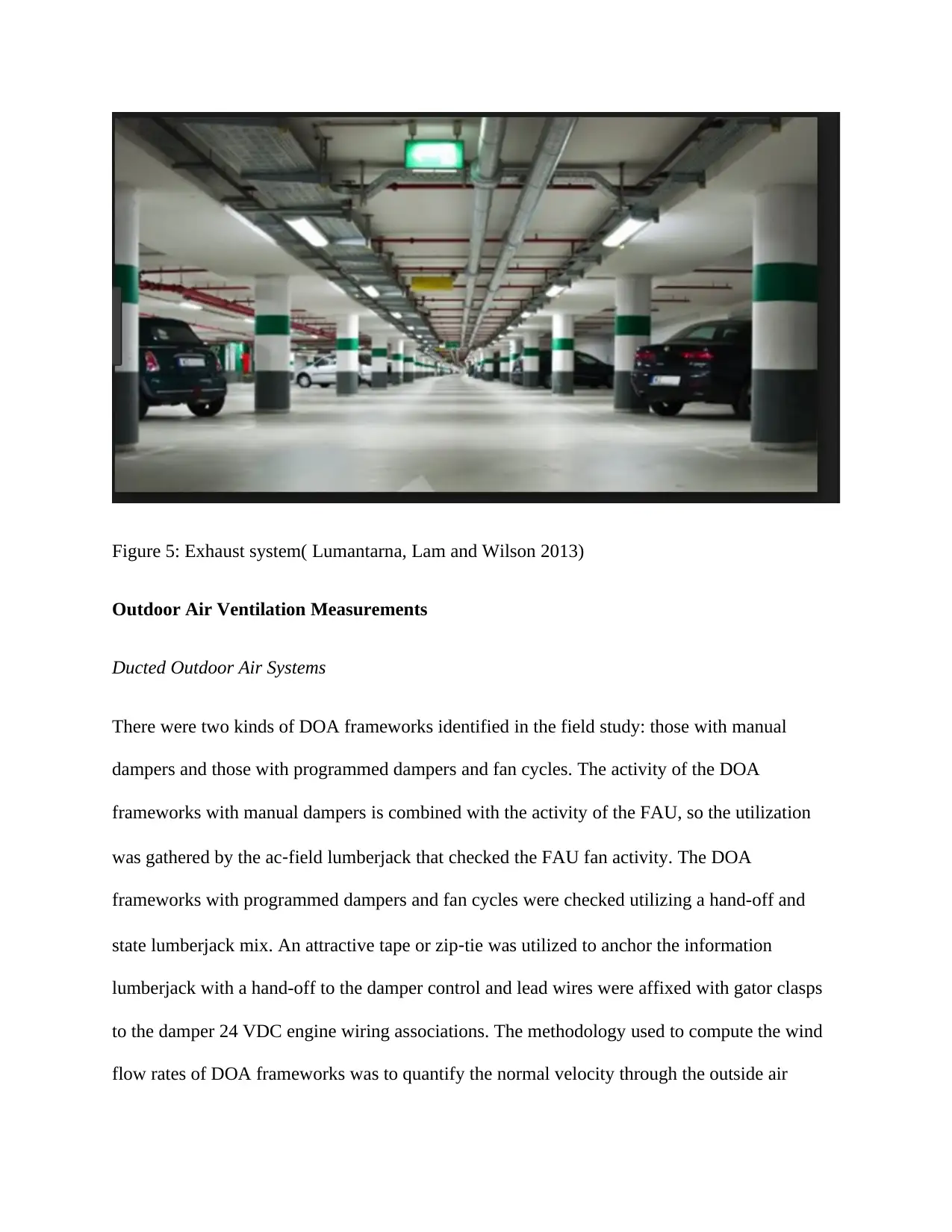
Figure 5: Exhaust system( Lumantarna, Lam and Wilson 2013)
Outdoor Air Ventilation Measurements
Ducted Outdoor Air Systems
There were two kinds of DOA frameworks identified in the field study: those with manual
dampers and those with programmed dampers and fan cycles. The activity of the DOA
frameworks with manual dampers is combined with the activity of the FAU, so the utilization
was gathered by the ac‐field lumberjack that checked the FAU fan activity. The DOA
frameworks with programmed dampers and fan cycles were checked utilizing a hand-off and
state lumberjack mix. An attractive tape or zip‐tie was utilized to anchor the information
lumberjack with a hand-off to the damper control and lead wires were affixed with gator clasps
to the damper 24 VDC engine wiring associations. The methodology used to compute the wind
flow rates of DOA frameworks was to quantify the normal velocity through the outside air
Outdoor Air Ventilation Measurements
Ducted Outdoor Air Systems
There were two kinds of DOA frameworks identified in the field study: those with manual
dampers and those with programmed dampers and fan cycles. The activity of the DOA
frameworks with manual dampers is combined with the activity of the FAU, so the utilization
was gathered by the ac‐field lumberjack that checked the FAU fan activity. The DOA
frameworks with programmed dampers and fan cycles were checked utilizing a hand-off and
state lumberjack mix. An attractive tape or zip‐tie was utilized to anchor the information
lumberjack with a hand-off to the damper control and lead wires were affixed with gator clasps
to the damper 24 VDC engine wiring associations. The methodology used to compute the wind
flow rates of DOA frameworks was to quantify the normal velocity through the outside air
⊘ This is a preview!⊘
Do you want full access?
Subscribe today to unlock all pages.

Trusted by 1+ million students worldwide
1 out of 23
Related Documents
Your All-in-One AI-Powered Toolkit for Academic Success.
+13062052269
info@desklib.com
Available 24*7 on WhatsApp / Email
![[object Object]](/_next/static/media/star-bottom.7253800d.svg)
Unlock your academic potential
Copyright © 2020–2025 A2Z Services. All Rights Reserved. Developed and managed by ZUCOL.





